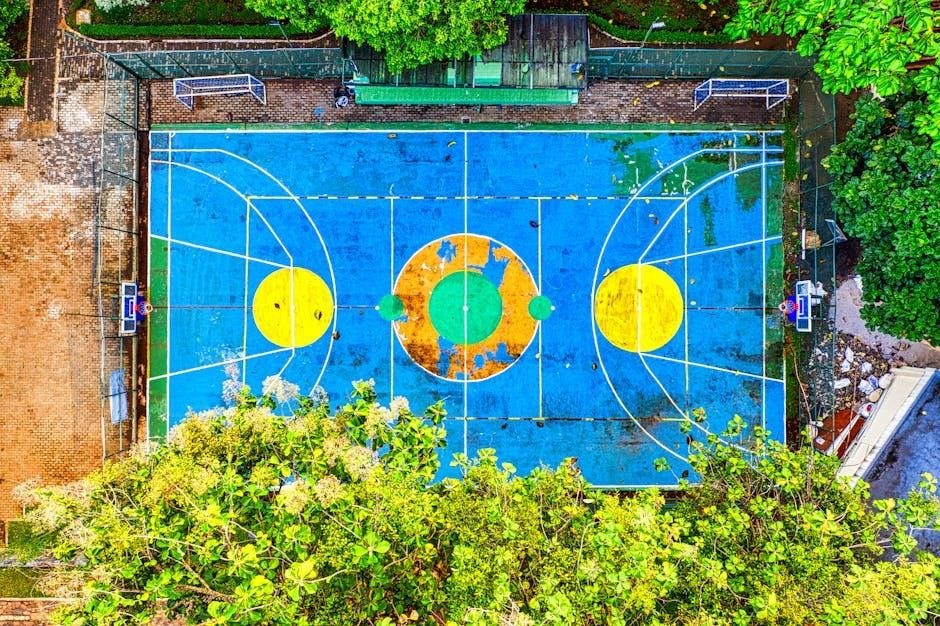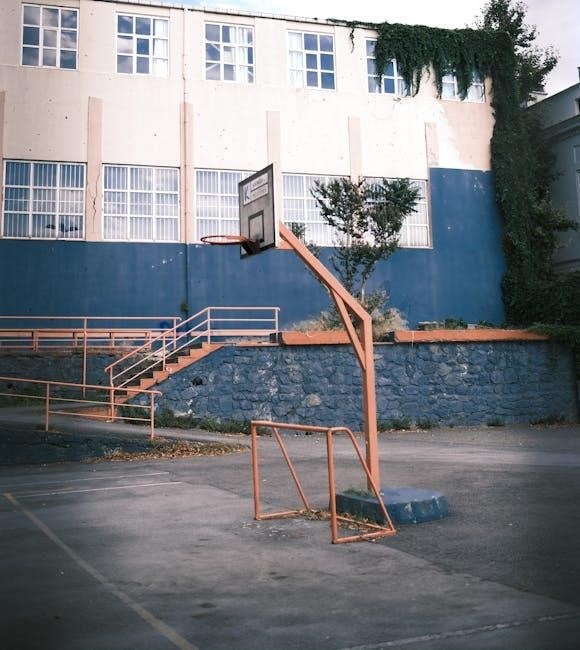high school basketball court dimensions pdf
Understanding the precise measurements of a high school basketball court is essential for safety‚ performance‚ and fair play. Accurate dimensions ensure a standardized playing field for all athletes‚ promoting consistency in training and competition; This guide provides a comprehensive overview of the court’s layout‚ including key features like the free throw line‚ three-point line‚ and overall court size‚ ensuring clarity for coaches‚ players‚ and facility designers.
Overview of the Importance of Court Dimensions
Accurate court dimensions are crucial for ensuring safety‚ fairness‚ and optimal performance in high school basketball. Proper measurements guarantee that all players compete on a standardized field‚ reducing the risk of injuries and inconsistencies. Standardized courts also allow coaches and players to develop strategies based on uniform conditions. Additionally‚ precise dimensions are essential for facility design and compliance with regulatory requirements. The National Federation of State High School Associations (NFHS) enforces these standards to maintain fairness across all levels of competition. Understanding and adhering to these measurements ensures a level playing field‚ fostering skill development and competitive balance.
Why Standardization Matters in High School Basketball
Standardization of high school basketball court dimensions ensures fairness and consistency across all games. It guarantees that players compete on equal terms‚ regardless of their school or location. Uniform court sizes prevent confusion and allow athletes to focus on skill development rather than adapting to varying layouts. Coaches can design strategies based on standardized measurements‚ knowing the court dimensions remain consistent. Additionally‚ standardized courts reduce the risk of injuries caused by uneven or inconsistent playing surfaces. The National Federation of State High School Associations (NFHS) enforces these standards to maintain a level playing field. This consistency is vital for fostering competitive balance and ensuring the integrity of the sport at all levels.

Standard High School Basketball Court Dimensions
A standard high school basketball court measures 84 feet in length and 50 feet in width‚ totaling 4‚200 square feet‚ ensuring consistent and safe play.
Length and Width Measurements
A high school basketball court is standardized at 84 feet in length and 50 feet in width‚ providing a consistent playing area for all levels of competition.
Key Differences from College and Professional Courts
High school basketball courts differ from college and professional courts primarily in length. While high school courts measure 84 feet long‚ college and NBA courts are 94 feet long‚ providing more space for players to maneuver. The width remains consistent at 50 feet across all levels. Another notable difference is the three-point line distance‚ which is shorter in high schools at 19 feet 9 inches compared to 20 feet 9 inches in college and 22 feet 9 inches in the NBA. These variations are designed to accommodate the developmental stages of players‚ ensuring fair competition and skill progression. Understanding these differences is crucial for coaches and players adapting to higher levels of play.
Official Measurements for Competitive Play
Official high school basketball court measurements are strictly regulated to ensure fair and safe competitive play. The court must be 84 feet in length and 50 feet in width‚ totaling 4‚200 square feet. The free throw line is positioned 15 feet from the backboard‚ while the three-point line is set at 19 feet 9 inches from the basket. The paint area‚ including the lane‚ measures 12 feet in width at each end of the court. These precise dimensions are mandated by governing bodies to maintain consistency across all high school competitions. Adhering to these measurements ensures player safety and equitable gameplay‚ allowing athletes to focus on skill development and teamwork without unnecessary variations in court layout.

Breakdown of Specific Measurements
A high school basketball court is 84 feet long and 50 feet wide‚ with a free throw line 15 feet from the backboard and a three-point line at 19 feet 9 inches. The paint area spans 12 feet‚ and the backboard measures 6 feet wide with a 10-foot rim height‚ ensuring precise and standardized gameplay.
Free Throw Line and Three-Point Line Distances
The free throw line in a high school basketball court is positioned 15 feet from the backboard‚ providing a consistent distance for shooters. The three-point line is set at 19 feet 9 inches from the basket‚ creating a clear boundary for long-range shots. These measurements are critical for maintaining fairness and precision in gameplay. The free throw line’s distance ensures shooters have a standardized challenge‚ while the three-point line’s placement defines the perimeter for scoring beyond the arc. Both lines are clearly marked to avoid confusion and ensure accurate officiating. Understanding these distances is vital for players‚ coaches‚ and officials to uphold the integrity of the game at the high school level.

Backboard and Rim Dimensions
The backboard and rim dimensions are critical components of a high school basketball court. The backboard is typically 6 feet wide and 4 feet tall‚ ensuring stability and support for the rim. The rim itself is standardized at 10 feet above the court surface‚ consistent with professional and collegiate levels. This uniform height ensures that players can develop their skills consistently across all levels of competition. The backboard is made of durable materials like glass or acrylic to withstand the impact of the ball and player contact. These measurements are essential for maintaining fair play and safety‚ and they are strictly regulated by governing bodies such as the National Federation of State High School Associations (NFHS).
Paint and Lane Measurements
The paint and lane measurements are essential components of a high school basketball court. The free throw lane‚ often referred to as “the paint‚” is 19 feet wide at the free throw line and tapers to 12 feet wide at the baseline‚ creating a trapezoidal shape. This design ensures proper spacing for players during free throws and rebounding. The three-point line is 23 feet‚ 9 inches from the basket‚ intersecting the top of the key. Additionally‚ the charge circle‚ a 3-foot radius area in front of the basket‚ is included within the paint to prevent defensive players from drawing fouls. These measurements are standardized to maintain consistency and fairness across all high school courts.

Comparative Analysis with Other Levels
High school courts are 84×50 feet‚ shorter than NCAA (94×50) and NBA (94×50) courts. The main differences are the three-point line distance and overall length‚ catering to varying player development stages.
High School vs. College Basketball Courts
High school basketball courts measure 84 feet in length and 50 feet in width‚ while college courts are larger at 94 feet long and 50 feet wide. The most notable difference is the length‚ with college courts being 10 feet longer. Additionally‚ the three-point line distance varies‚ with high school courts having a shorter line at 19.9 feet from the basket‚ compared to 22.15 feet in college. These differences are designed to accommodate varying skill levels and player development stages. The wider court in college basketball allows for more strategic play and faster-paced games‚ preparing athletes for professional leagues. Understanding these dimensions is crucial for players transitioning from high school to college-level competition.
High School vs. NBA Basketball Courts
High school and NBA basketball courts differ significantly in size and layout. NBA courts are larger‚ measuring 94 feet in length and 50 feet in width‚ while high school courts are 84 feet long and 50 feet wide. The most notable difference is the three-point line distance‚ with the NBA line being 23 feet‚ 9 inches from the basket‚ compared to 19 feet‚ 9 inches in high school. Additionally‚ the NBA court features a wider lane (16 feet) and a longer free throw line distance (15 feet). These variations reflect the higher skill level and physical demands of professional play. Understanding these differences helps players and coaches adapt strategies for different levels of competition‚ emphasizing the importance of standardized measurements for fair and competitive gameplay.
International Basketball Court Dimensions
International basketball courts‚ governed by FIBA‚ have distinct dimensions compared to high school courts. FIBA courts measure 28 meters in length (approximately 91.9 feet) and 15 meters in width (approximately 49.2 feet). The three-point line is set at 6.75 meters (22.1 feet) from the basket‚ slightly shorter than the NBA’s 23 feet‚ 9 inches. The free throw line is 5.8 meters (19 feet) from the backboard‚ and the lane is wider at 4.5 meters (14.8 feet). These measurements ensure uniformity across global competitions‚ fostering fair play and standardization. The differences highlight how court dimensions adapt to varying levels of competition‚ from high school to international play‚ each with specific requirements to enhance performance and safety.

Downloading the PDF Guide

Official PDF guides provide detailed high school basketball court dimensions‚ diagrams‚ and design tips. Available on sports associations’ websites‚ they help coaches‚ players‚ and facility designers ensure accuracy and compliance with regulations.
Where to Find Official PDF Resources
Official PDF resources for high school basketball court dimensions can be found on authoritative sports organizations’ websites‚ such as the National Federation of State High School Associations (NFHS) or local athletic associations. These guides provide detailed diagrams‚ measurements‚ and layout specifications to ensure compliance with regulations. Additionally‚ sports equipment manufacturers and educational institutions often offer downloadable PDFs tailored for court design and construction. Always verify the credibility of the source to ensure accuracy and avoid errors in implementation. These resources are invaluable for coaches‚ facility designers‚ and administrators aiming to create safe and regulation-compliant basketball courts. Accessing these PDFs is straightforward‚ making it easier to plan and execute court projects effectively.

How to Use the PDF for Court Design
Utilizing the PDF guide for high school basketball court design ensures accuracy and compliance with official standards. Begin by reviewing the detailed diagrams and measurements provided‚ which outline the court’s length‚ width‚ and key features like the free throw line and three-point line. These specifications serve as a blueprint for architects and contractors. The PDF often includes labeled dimensions‚ making it easier to visualize and implement the design. Additionally‚ cross-referencing the guide with local regulations ensures all safety and performance standards are met. By following the PDF’s instructions‚ designers can create a functional and regulation-compliant court‚ fostering optimal play and safety for athletes. This step-by-step approach streamlines the design process‚ minimizing errors and ensuring a professional outcome.
Benefits of Having a PDF Guide
A PDF guide for high school basketball court dimensions offers numerous advantages‚ particularly for designers‚ coaches‚ and facility planners. It provides a clear‚ concise‚ and easily shareable resource that ensures everyone involved in court construction or renovation is on the same page. The PDF format maintains consistent formatting across devices‚ making it a reliable reference for accurate measurements. Additionally‚ it serves as a quick lookup tool‚ saving time compared to searching through lengthy documents or websites. Having a PDF guide also ensures that the latest standards are readily accessible‚ reducing the risk of errors in court design. This centralized resource is invaluable for maintaining consistency and compliance with official regulations‚ making it an essential tool for anyone involved in creating or upgrading a basketball court.

Historical Changes in Court Dimensions
Over time‚ high school basketball court dimensions have evolved‚ with notable changes like the three-point line distance increasing from 20’9″ to 22’1.75″ in 2024. These adjustments aim to enhance player safety and performance‚ aligning with modern gameplay demands while maintaining fairness across all levels of competition.
Evolution of the Three-Point Line
The three-point line has undergone significant changes over the years‚ with its introduction in 1987 at 19’9″ and subsequent adjustments to enhance gameplay. In 2024‚ the line was moved from 20’9″ to 22’1.75″ in high school basketball‚ aligning with college and international standards. This change aimed to reduce congestion in the paint‚ promote outside shooting‚ and balance scoring. The evolution reflects adaptations to modern player skills and strategic play‚ ensuring the game remains dynamic and competitive. These adjustments highlight the sport’s commitment to innovation while maintaining fair and engaging competition across all levels.
Adjustments for Player Safety and Performance
High school basketball court dimensions have been refined to prioritize player safety and enhance performance. The width of the lane was increased to reduce collisions‚ while the backboard height and rim dimensions were standardized to prevent injuries. Adjustments to the free throw line and three-point line distances ensure fair shooting opportunities. Additionally‚ the overall court size and markings were optimized to improve player movement and reduce congestion. These modifications reflect a commitment to creating a safer and more balanced playing environment‚ allowing athletes to perform at their best without compromising safety. Regular updates to court dimensions demonstrate the sport’s adaptability to evolving player needs and competitive demands.

Frequently Asked Questions
This section covers key questions about high school basketball court dimensions‚ ensuring clarity on measurements‚ markings‚ and layout for construction‚ training‚ and fair competition purposes.
Common Queries About High School Courts
Common questions about high school basketball courts often revolve around their dimensions and specific measurements. Many ask about the length and width‚ which are 84 feet by 50 feet. Others inquire about the three-point line distance‚ which is 20 feet 9 inches. Additionally‚ there are questions about the free throw line distance (15 feet) and the size of the backboard (72 inches wide). People also wonder how high school courts differ from college and NBA courts‚ noting the shorter length and closer three-point line. Finally‚ many seek reliable sources for official court diagrams‚ with PDF guides being a popular request for precise measurements and layouts.
Misconceptions About Court Dimensions
One common misconception is that all basketball courts‚ regardless of level‚ have the same dimensions. However‚ high school courts are smaller than college and NBA courts‚ with a length of 84 feet compared to 94 feet for professional and collegiate levels. Another misconception is that the three-point line distance is uniform across all levels‚ when in fact‚ it is shorter in high school (20 feet 9 inches) than in college (22 feet 1.75 inches) and the NBA (23 feet 9 inches). Additionally‚ some believe that older high school gyms may have smaller courts‚ but they still adhere to the standard 84×50 feet dimensions. Understanding these differences is crucial for accurate court design and fair play.
Accurate high school basketball court dimensions are vital for fair play and safety. Standardized measurements ensure consistency‚ while the PDF guide provides precise designs for optimal performance.
Final Thoughts on High School Basketball Court Dimensions
Accurate court dimensions are crucial for fair play and safety in high school basketball. The standard size of 84 feet by 50 feet ensures consistency across all levels‚ while specific measurements like the free throw line (15 feet) and three-point line (19.9 feet) maintain competitive integrity. The PDF guide provides a detailed layout‚ helping coaches‚ players‚ and facility designers understand the court’s structure. Adhering to these standards promotes uniformity‚ safety‚ and optimal performance. By following official guidelines‚ high schools can create courts that foster skill development and excitement for the game. Downloading the PDF ensures precise measurements‚ making it an invaluable resource for court construction or renovation.
Importance of Accurate Measurements for Fair Play
Accurate measurements are vital for ensuring fair play in high school basketball. Consistent court dimensions guarantee that all players compete on an equal field‚ maintaining competitive balance. Precise markings‚ such as the free throw line (15 feet) and three-point line (19.9 feet)‚ ensure that rules are uniformly applied. Inaccurate measurements could lead to unfair advantages or safety hazards. Properly sized courts also allow players to train and perform effectively‚ as they can rely on standardized distances for shooting and movement. By adhering to official guidelines‚ high schools promote a fair and safe environment for athletes‚ fostering the integrity of the game at all levels.
